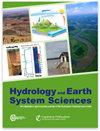Biocrust-reduced soil water retention and soil infiltration in an alpine Kobresia meadow
IF 5.8
1区 地球科学
Q1 GEOSCIENCES, MULTIDISCIPLINARY
引用次数: 0
Abstract
Abstract. Biocrust is a key component of ecosystems and plays a vital role in altering hydrological processes in terrestrial ecosystems. The impacts of biocrust on hydrological processes in arid and semi-arid ecosystems have been widely documented. However, the effects and mechanisms of biocrust on soil hydrological processes in alpine ecosystems are still poorly understood. In this study, we selected two meadow types from the northern Qinghai–Tibet Plateau: normal Kobresia meadow (NM) and biocrust meadow (BM). Both the soil hydrological and physicochemical properties were examined. We found that, in the 0–30 cm soil layer, soil water retention and soil water content in NM were higher than those in BM, whereas the 30–40 cm layer's soil water retention and soil water content in NM were lower than those in BM. The topsoil infiltration rate in BM was lower than that in NM. Furthermore, the physicochemical properties were different between NM and BM. The 0–10 cm soil layer's clay content in BM was 9 % higher than that in NM, whereas the 0–30 cm layer's soil capillary porosity in NM was higher than that in BM. In addition, the 0–20 cm layer's soil total nitrogen (TN) and soil organic matter (SOM) in NM were higher than those in BM, implying that the presence of biocrust may not favor the formation of soil nutrients owing to its lower soil microbial biomass carbon and microbial biomass nitrogen. Overall, soil water retention was determined by SOM by altering the soil capillary porosity and bulk density. Our findings suggest that the establishment of cyanobacteria crust biocrust may not improve soil water retention and infiltration, and the soil in cyanobacteria crust meadows could be more vulnerable to runoff generation and consequent soil erosion. These results provide a systematic and comprehensive understanding of the effects of biocrust on the soil hydrology of alpine ecosystems.高山鹅掌楸草甸的生物覆盖层降低了土壤保水性和土壤渗透性
摘要。生物结壳是生态系统的重要组成部分,在改变陆地生态系统水文过程中起着至关重要的作用。生物结皮对干旱和半干旱生态系统水文过程的影响已被广泛记载。然而,生物结皮对高寒生态系统土壤水文过程的影响及其机制尚不清楚。本研究选取青藏高原北部两种草甸类型:普通矮嵩草草甸(NM)和生物硬壳草甸(BM)。测定了土壤的水文性质和理化性质。我们发现,在0-30 cm土层中,NM的土壤保水率和土壤含水量高于BM,而在30-40 cm土层中NM的土壤保水率和土壤含水量低于BM。BM的表层土壤入渗速率低于NM。此外,NM和BM的理化性质也有所不同。0 ~ 10 cm土层土壤粘粒含量比普通土层高9%,0 ~ 30 cm土层土壤毛管孔隙率比普通土层高。此外,0 ~ 20 cm土层土壤全氮(TN)和土壤有机质(SOM)均高于壤土,说明生物结皮的存在可能不利于土壤养分的形成,土壤微生物生物量碳和微生物生物量氮含量较低。总体而言,SOM通过改变土壤毛管孔隙度和容重来确定土壤保水能力。研究结果表明,蓝藻结皮的建立可能不会改善土壤的保水和入渗,而且蓝藻结皮草甸的土壤更容易受到径流产生和土壤侵蚀的影响。这些结果为系统、全面地了解生物结壳对高寒生态系统土壤水文的影响提供了依据。
本文章由计算机程序翻译,如有差异,请以英文原文为准。
求助全文
约1分钟内获得全文
求助全文
来源期刊

Hydrology and Earth System Sciences
地学-地球科学综合
CiteScore
10.10
自引率
7.90%
发文量
273
审稿时长
15 months
期刊介绍:
Hydrology and Earth System Sciences (HESS) is a not-for-profit international two-stage open-access journal for the publication of original research in hydrology. HESS encourages and supports fundamental and applied research that advances the understanding of hydrological systems, their role in providing water for ecosystems and society, and the role of the water cycle in the functioning of the Earth system. A multi-disciplinary approach is encouraged that broadens the hydrological perspective and the advancement of hydrological science through integration with other cognate sciences and cross-fertilization across disciplinary boundaries.
 求助内容:
求助内容: 应助结果提醒方式:
应助结果提醒方式:


